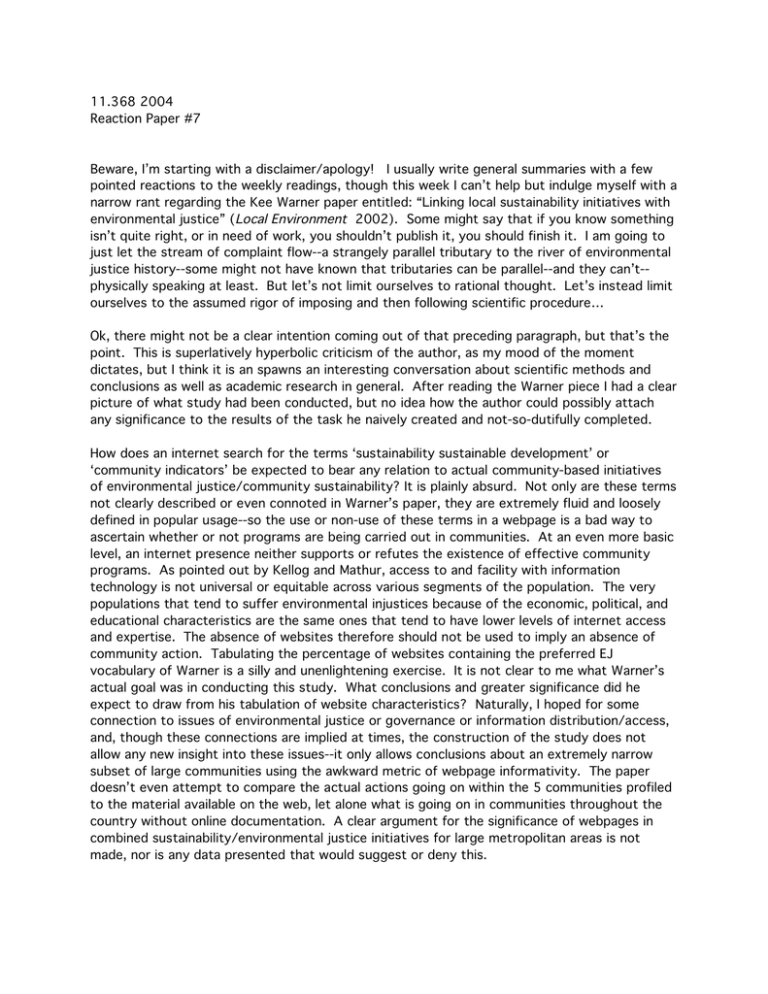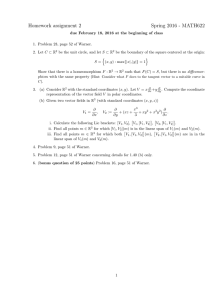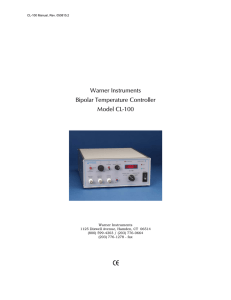11.368 2004 Reaction Paper #7
advertisement

11.368 2004 Reaction Paper #7 Beware, I’m starting with a disclaimer/apology! I usually write general summaries with a few pointed reactions to the weekly readings, though this week I can’t help but indulge myself with a narrow rant regarding the Kee Warner paper entitled: “Linking local sustainability initiatives with environmental justice” (Local Environment 2002). Some might say that if you know something isn’t quite right, or in need of work, you shouldn’t publish it, you should finish it. I am going to just let the stream of complaint flow--a strangely parallel tributary to the river of environmental justice history--some might not have known that tributaries can be parallel--and they can’tphysically speaking at least. But let’s not limit ourselves to rational thought. Let’s instead limit ourselves to the assumed rigor of imposing and then following scientific procedure… Ok, there might not be a clear intention coming out of that preceding paragraph, but that’s the point. This is superlatively hyperbolic criticism of the author, as my mood of the moment dictates, but I think it is an spawns an interesting conversation about scientific methods and conclusions as well as academic research in general. After reading the Warner piece I had a clear picture of what study had been conducted, but no idea how the author could possibly attach any significance to the results of the task he naively created and not-so-dutifully completed. How does an internet search for the terms ‘sustainability sustainable development’ or ‘community indicators’ be expected to bear any relation to actual community-based initiatives of environmental justice/community sustainability? It is plainly absurd. Not only are these terms not clearly described or even connoted in Warner’s paper, they are extremely fluid and loosely defined in popular usage--so the use or non-use of these terms in a webpage is a bad way to ascertain whether or not programs are being carried out in communities. At an even more basic level, an internet presence neither supports or refutes the existence of effective community programs. As pointed out by Kellog and Mathur, access to and facility with information technology is not universal or equitable across various segments of the population. The very populations that tend to suffer environmental injustices because of the economic, political, and educational characteristics are the same ones that tend to have lower levels of internet access and expertise. The absence of websites therefore should not be used to imply an absence of community action. Tabulating the percentage of websites containing the preferred EJ vocabulary of Warner is a silly and unenlightening exercise. It is not clear to me what Warner’s actual goal was in conducting this study. What conclusions and greater significance did he expect to draw from his tabulation of website characteristics? Naturally, I hoped for some connection to issues of environmental justice or governance or information distribution/access, and, though these connections are implied at times, the construction of the study does not allow any new insight into these issues--it only allows conclusions about an extremely narrow subset of large communities using the awkward metric of webpage informativity. The paper doesn’t even attempt to compare the actual actions going on within the 5 communities profiled to the material available on the web, let alone what is going on in communities throughout the country without online documentation. A clear argument for the significance of webpages in combined sustainability/environmental justice initiatives for large metropolitan areas is not made, nor is any data presented that would suggest or deny this.








